

Subjects: Bayonets, Bolt Design, Early Variations, CR39 Paratrooper Version, LG48 Modification, 1936/51 Model, Estimated Serial Number Distribution, Foriegn Use, Ownership, Notes. "Je suis Charlie"
| Article by Steve N. Jackson (v.1) |
The MAS Mle 1936 and its variants served as the standard French rifle from 1936 until 1956, and was withdrawn from service, except for those designed for sniping, in the 1970s. The MAS Mle 1936 was the last bolt-action rife adopted as a standard infantry arm of any world power, and it was arguably the easiest to maintain weapon of its type. Like the British Enfield it was a good enough design to survive into the beginning of the automatic rifle era and was popular with its users both as a rifle, and as a platform for launching grenades.
Like all articles on this website, this is a work in progress. Clear academic sources for the history of this weapon are difficult to find, and many sources are in French, which the author is a slow reader of at best.
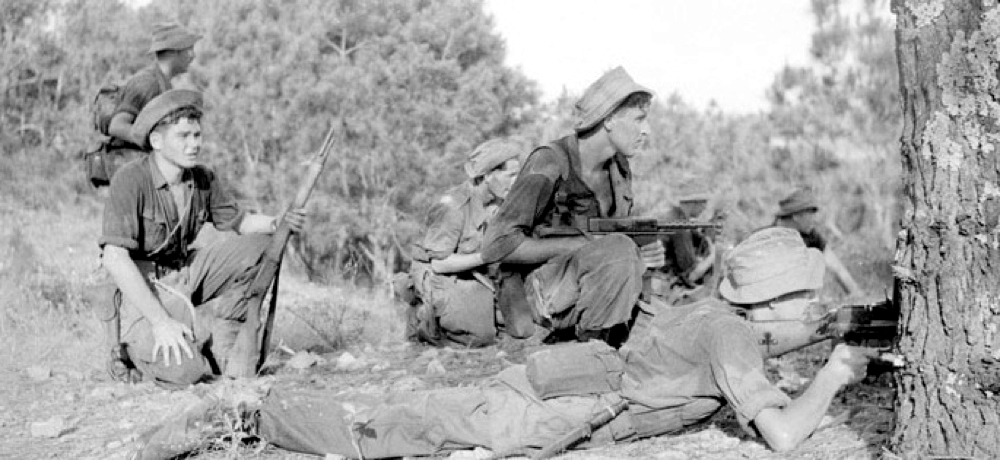
| Model | Cartridge | Length | Weight | Barrel | Magazine | ||
| MAS Mle 1932(1) | 7.5x54mm | 1020mm | 3.78kg | 575mm | 5rd Mauser Type | ||
| MAS Mle 1936 | 7.5x54mm | 1020mm | 3.78kg | 575mm | 5rd Mauser Type | ||
| MAS Mle 1936 CR39 | 7.5x54mm | 886mm | 3.1kg | 450mm | 5rd Mauser Type | ||
| MAS Mle 1936 LG48 | 7.5x54mm | 1020mm | 3.9kg | 575mm | 5rd Mauser Type | ||
| MAS Mle 1936/51 | 7.5x54mm | 1020mm | 3.9kg | 575mm | 5rd Mauser Type | ||
| MAS Mle FR-F1 | 7.5x54mm and 7.62x51mm |
1138mm | 5.2kg | 552mm | 10rd Box Magazine | ||
| MAS Mle FR-F2 | 7.62x51mm | 1138mm | 5.2kg | 552mm | 10rd Box Magazine | ||
| MAS Mle FR-G1 | 7.62x51mm | 1138mm | 4.8kg | 552mm | 10rd Box Magazine | ||
| MAS Mle FR-G2 | 7.62x51mm | 1138mm | 4.9kg | 552mm | 10rd Box Magazine | ||
The Great War caught the French Army half-way through a design process that it had intended would result in a universal, semi-automatic rifle and carbine. 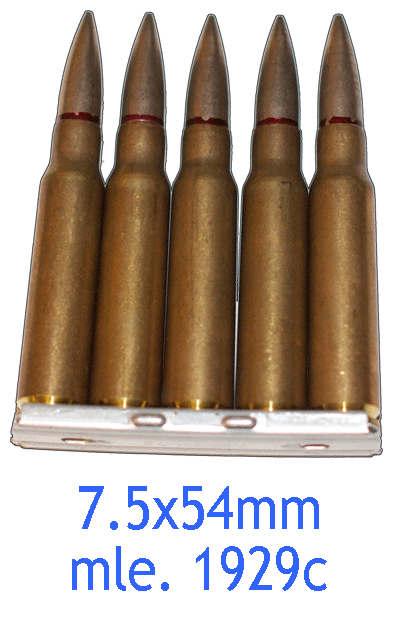 Work on the project slowed in 1911 and by the start of the Great War adoption of a new rifle firing a modern, rimless ammunition was problematic - the entire French supply system was geared to the 8x50Rmm Lebel round. As a result, the war would be fought primarily by the rugged Berthier and the cranky, expensive Mle 1886.
Work on the project slowed in 1911 and by the start of the Great War adoption of a new rifle firing a modern, rimless ammunition was problematic - the entire French supply system was geared to the 8x50Rmm Lebel round. As a result, the war would be fought primarily by the rugged Berthier and the cranky, expensive Mle 1886.
The process of adopting the "ultimate rifle" did not stop though. French gunsmiths were at the cutting edge of firearm design, even if they suffered from fiscal restraints that kept them from fielding the best of their designs. During the war though new French assault tactics came into being to deal with attacking German machine gun nests. The result was a new generation of very reliable automatic weapons (the Chauchat being the most famous) and modifications for the older rifles like the Berthier. A semi-automatic rifle was even designed to use the 8mm Lebel round (the RSC Mle 1917), but the limitations of this cartridge were well known, and any attempt to use it in a modern firearm were simply stopgaps.
After the war the French Army was left with millions of bolt action weapons and around 80,000 Mle 1917 and Mle 1918 autoloading rifles, all firing the obsolete 8x50R Lebel. Picking back up where they left off efforts were made to adopt a new cartridge and a series of weapons to fire it. The new cartridge would become (after a single mistep) the 7.5x54mm Mle. 1929c, first chambered in the FM 1929 light machine gun.
With the Army standardized on a single ammunition calibre efforts started on developing three different weapons to use it, a Berthier conversion designed to save some of the million plus Berthier rifles in armories across France, a bolt action replacement for the Berthier for use by second line troops, and a semi-automatic rifle for front line troops. The Berthier rebuild would be built in small quantities as the Fusil Mle 1907/15 m34, the semi-automatic rifle would become the Fusil MAS Mle 1940, while the repeating, bolt-action magazine rifle would become the Fusil MAS Mle 1936.
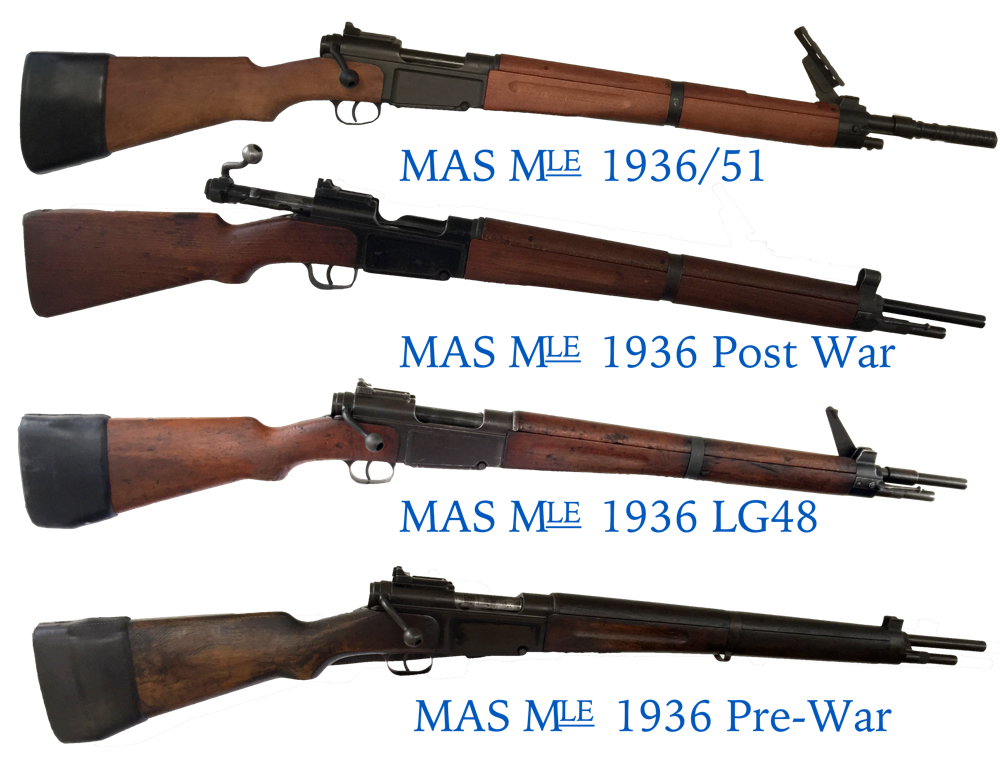
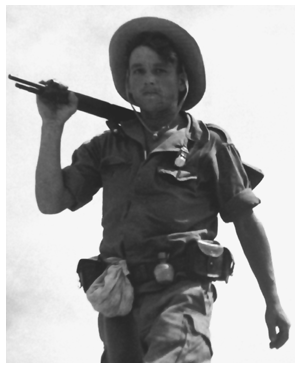 When designing the MAS Mle 1936 rifle Manufacture d'armes de Saint-Étienne set as a goal creating a weapon that was very reliable, with a minimum of parts, that was easy to manufacture, and that would serve second-line troops even if they ended up fighting at the front line. The new weapon would have a magazine capacity of at least five rounds, be able to accept Mauser style stripper clips, and would not require a safety to be fitted. The ideal weapon would be able to dump its ammunition in a single action, and the ammunition feed should be able to be pulled from the receiver for cleaning. A removable magazine was considered (along the lines of the Lee Enfield) but was rejected due to expense. Instead the new rifle would have a guide machined in it for a stripper clip.
When designing the MAS Mle 1936 rifle Manufacture d'armes de Saint-Étienne set as a goal creating a weapon that was very reliable, with a minimum of parts, that was easy to manufacture, and that would serve second-line troops even if they ended up fighting at the front line. The new weapon would have a magazine capacity of at least five rounds, be able to accept Mauser style stripper clips, and would not require a safety to be fitted. The ideal weapon would be able to dump its ammunition in a single action, and the ammunition feed should be able to be pulled from the receiver for cleaning. A removable magazine was considered (along the lines of the Lee Enfield) but was rejected due to expense. Instead the new rifle would have a guide machined in it for a stripper clip.
The initial design that would become the Mle 1936 was finished in 1932, along with an aluminum stripper clip for the 7.5x54mm. This design was a short rifle with a wooden, three-piece stock of simple to maintain oak (later beech was adopted because it weathered better in the tropics), a slab sided receiver, and a simple bolt. The weapon was tested for a year and small changes were made as (resulting in the MAS 1934 and 1935 rifles, none of which were put into serial production). Full production was not started until 1936, with the weapon getting the designation the Fusil MAS Mle 1936. Although plans were in motion to replace it with an autoloading rifle for front line service (the Fusil MAS Mle 1940), it was officially adopted as the French Army's standard rifle until the new rifle arrived. More than 200,000 were in French hands before the fall of France in 1940, and in service it proved to be an excellent and reliable design.

 A soldier of the Great War would carry 40 rounds into combat, with the assumption that their most useful weapon was their bayonet. As that war went on the infantry were issued six grenades, several rifle grenades and a launcher, an additional 120 rounds of ammunition, magazines for the team's light automatic weapon, signal flares, and sometimes a pack of demolitions explosives. The French infantry tactics developed under Petain had the soldiers attack without packs, but they replaced the weight with ordnance. Petain also discouraged the use of bayonets as an offensive weapon - preferring that soldiers carry a machete if they needed an edged weapon at all.
A soldier of the Great War would carry 40 rounds into combat, with the assumption that their most useful weapon was their bayonet. As that war went on the infantry were issued six grenades, several rifle grenades and a launcher, an additional 120 rounds of ammunition, magazines for the team's light automatic weapon, signal flares, and sometimes a pack of demolitions explosives. The French infantry tactics developed under Petain had the soldiers attack without packs, but they replaced the weight with ordnance. Petain also discouraged the use of bayonets as an offensive weapon - preferring that soldiers carry a machete if they needed an edged weapon at all.
Despite the end of the futile bayonet charge as a tactic, soldiers still wanted something on the end of their rifle. Rifle bayonets were used by soldiers to search for mines, prod objects that may be booby trapped, raise signal flags, and poke at things the infantry would prefer not to touch. Designers of the new rifle thus wanted to have a light-weight bayonet on the weapon that could be used without weighing down the soldiers.
The MAS Mle 1936 was given an internal bayonet, cut down to its minimum size and weight and slung conveniently under the barrel. It was not intended to replace a knife, which was also issued, so there was no provisions for sharpening it except at its tip. The weapon proved popular with troops but despite its small size and handy storage position, it was still an additional weight burden on French soldiers who were gradually being asked to carry more ammunition. The MAS Mle 36 and the MAS Mle 1944 would be the last rifles to carry a spike bayonet.
| Top |

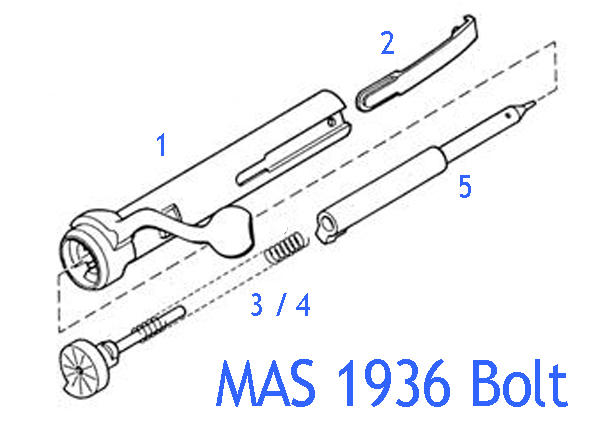 The Fusil MAS Mle 1936 Bolt Design
The Fusil MAS Mle 1936 Bolt Design
The MAS Mle 1936 bolt design eliminated most of the bad features of the the Berthier and the Mauser bolts. A solid bolt body machined as a single piece has two bolt locking heads which fit into the rear of the rifle's receiver. The rear locking bolt heads, similar to those found on the British Enfield series rifle, are weaker than the Mauser design but provide a more reliable lock in dirty conditions, and do not jam mud or soil into the bore when the action is cycled.
| 1 | One piece bolt body with rear locking lugs. |
| 2 | Extractor |
| 3 | Mainspring |
| 4 | Bolt Head |
| 5 | Firing Pin |
The MAS Mle 1936 retains the Berthier style claw extractor, which can be removed with a small shiv or the edge of a cartridge and a striker activated firing pin like the Mauser and Berthier. The bolt eliminates the external portions of the firing striker found on the Berthier (allowing the face to be positioned closer to the sights), instead trading it with a simple mainspring and fixed to the bolt head. The bolt is held into the receiver by the trigger mechanism, and can be removed simply by opening it then pulling the trigger as the bolt is removed, eliminating the screw on the Berthier or the elegant but complicated lifting lever of the Mauser.
The bolt thus has only five parts, none of them small or easily lost, and can be disassembled in the roughest conditions mostly by the hand (or at most using a cartridge to prise out the extractor). The design also made the MAS Mle 1936 bolt extremely cheap to manufacture while at the same time making it one of the most rugged bolt designs of any modern repeating rifle. A particularly strong design point is that the firing pin can simply be dropped out of the bolt body. Both the Mauser and Berthier designs suffer from broken firing pins when soldiers try to remove the pin on a uneven or unsuitable surface.
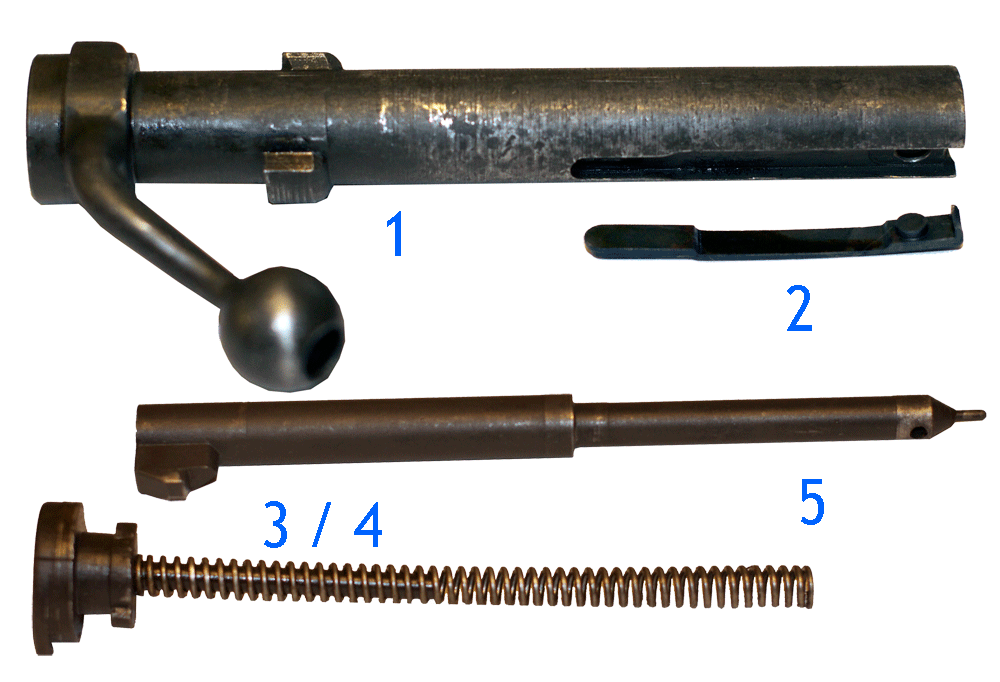
| Top |
Early Fusil MAS Mle 1936 Design Elements
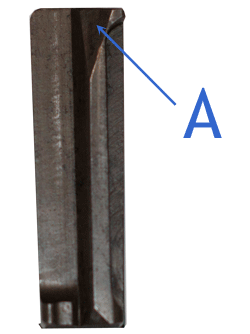 The Mle 1936 started entering the French service in early 1937, equipping front-line units along side the Berthier Mle 1907/15 m34 models. These pre-war models are unique from later rifles of the same model in a number of ways, although it is rare to find these weapons with their original hardware as post-war arsenal rebuilds replaced older hardware with newer when in came in (2).
The Mle 1936 started entering the French service in early 1937, equipping front-line units along side the Berthier Mle 1907/15 m34 models. These pre-war models are unique from later rifles of the same model in a number of ways, although it is rare to find these weapons with their original hardware as post-war arsenal rebuilds replaced older hardware with newer when in came in (2).
The first element found on pre-war weapons is a notched magazine follow (A) that allows the bolt to close on an empty magazine. 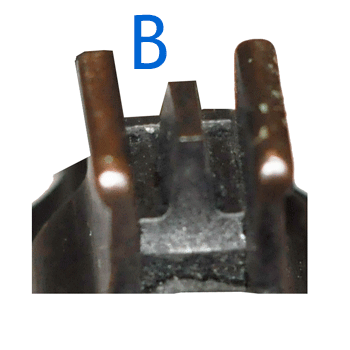 All French repeating rifles prior to the MAS Mle 1936 could close on an empty chamber without the magazine follower blocking the bolt, so this design was not surprising.
All French repeating rifles prior to the MAS Mle 1936 could close on an empty chamber without the magazine follower blocking the bolt, so this design was not surprising.
During the Second Wold War it was found that soldiers in the heat of battle would often close their bolts on empty chambers wasting time before they would reload. This was never seen as a problem before the war, but after the war bolt hold-opens became standard for both the repeating rifles, and the MAS Mle 44 series semi-automatic rifle. The original followers are somewhat rare in the current market - spare parts for the MAS Mle 1936 are usually bolt-hold open types. The notched followers are usually found on weapons that lack import marks.
Early MAS Mle 1936 models had front sights protected by two ears (B). The blade of the sight is identical to later weapons, but the ears are attached using a heavy end cap, so it is common to see early weapons where these ears have been removed and replaced with the lighter circular model that surrounds the entire sight. The likely reason for the change from the ears to the circular model is expense. 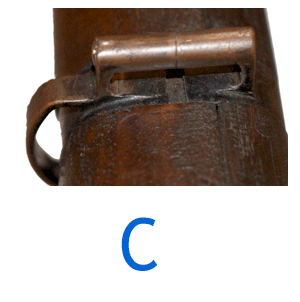 Both model protect the front sight from damage, but the original front-cap is heavier forged steel and is assembled from at least three parts.
Both model protect the front sight from damage, but the original front-cap is heavier forged steel and is assembled from at least three parts.
Early models of the 1936 had a slightly different rear sight design. The early rear sight is moved by pressing down on the peep and sliding the sight adjustment along the bent sight leaf, while the later versions have a button that releases tension allowing the sight to move freely.
The early model MAS Mle 1936 rifles also had forged steel fore grip retainers (C) with hinges and two mounting points for slings (3). The trigger and trigger guard were also changed(4).
All of the early and later modifications are interchangeable, and can occasionally be found on weapons that should not have them. In addition to the parts changes, early guns are painted black over a light parkerization, while later rifles have a traditional grey parkerization.
Early model Mle 1936 are at best uncommon. Original weapons are often found with pre-war oak stocks (noticeable by being considerably darker than the post war beech stocks) and many are in poor condition after service during World War Two in both French and German hands. Many shooters prefer the pre-war forged parts because of their durability, and it is common to find the older parts mated to newer weapons.
| Top |
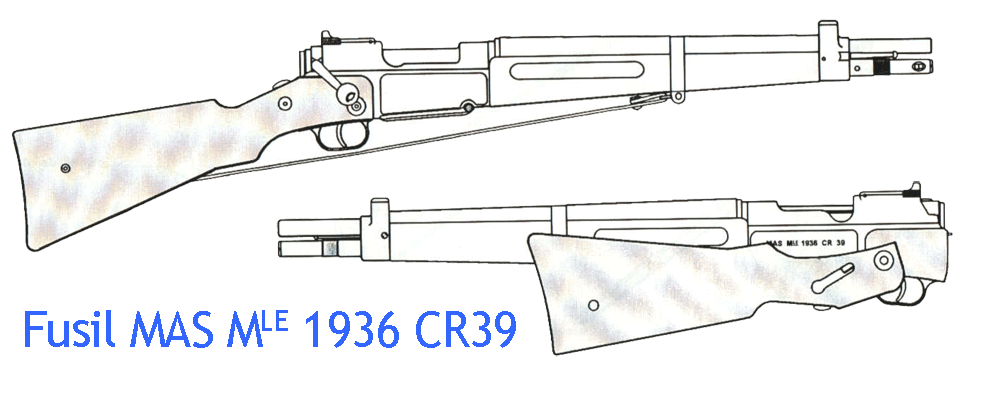
The Fusil MAS Mle 1936 CR39 Paratrooper / Folding Stock Model
In 1939 a variant was created for paratroopers, the MAS Mle 1936 CR39(5). The CR39 had an aluminum stock that could be folded to the side of the weapon and an odd but very useful spring mechanism to deal with the shoulder strap when thus folded. 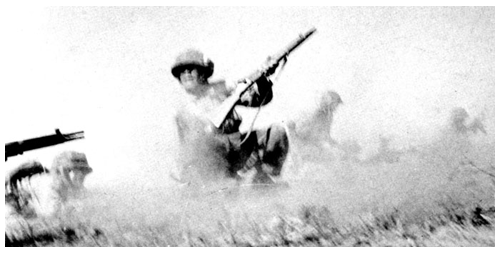 These rifles were converted from regular weapons as needed to equip paratroopers. Early models were sent to the Groupe de l'infanterie de l'air 601 with plans to replace the Berthier Mle 1892 m16s then issued, but the war intervened before the weapon was widely adopted. By 1940 when Groupe de l'infanterie de l'air 601 was transferred to North Africa and disbanded less than one-hundred of the rifles had been delivered, but no record exists of them ever serving in combat. In 1944 the CR39 was again being produced, although French airborne units were mostly equipped with American weapons. Example of the weapon were present at Dien Bein Phu, and were used in Algeria. Their last front-line use was the Suez crisis when they were successful as counter-sniper weapons in the hands of well-trained French paratroopers.
These rifles were converted from regular weapons as needed to equip paratroopers. Early models were sent to the Groupe de l'infanterie de l'air 601 with plans to replace the Berthier Mle 1892 m16s then issued, but the war intervened before the weapon was widely adopted. By 1940 when Groupe de l'infanterie de l'air 601 was transferred to North Africa and disbanded less than one-hundred of the rifles had been delivered, but no record exists of them ever serving in combat. In 1944 the CR39 was again being produced, although French airborne units were mostly equipped with American weapons. Example of the weapon were present at Dien Bein Phu, and were used in Algeria. Their last front-line use was the Suez crisis when they were successful as counter-sniper weapons in the hands of well-trained French paratroopers.
Original CR39s are quite rare. Few were important into the United States (although spare stocks were sold here and sometimes were used to retrofit Mle 1936 models - notable by the longer barrel) and many were destroyed in action. The original CR39 conversions were made on weapons with the older forged steel components. Most arsenal weapons have a shorter barrel, a shorter bayonet holder, and are stamped CR39 at the factory. Modern MAS Mle 1936 CR39 command a high price, and are generally out of range of the casual shooter / collector.
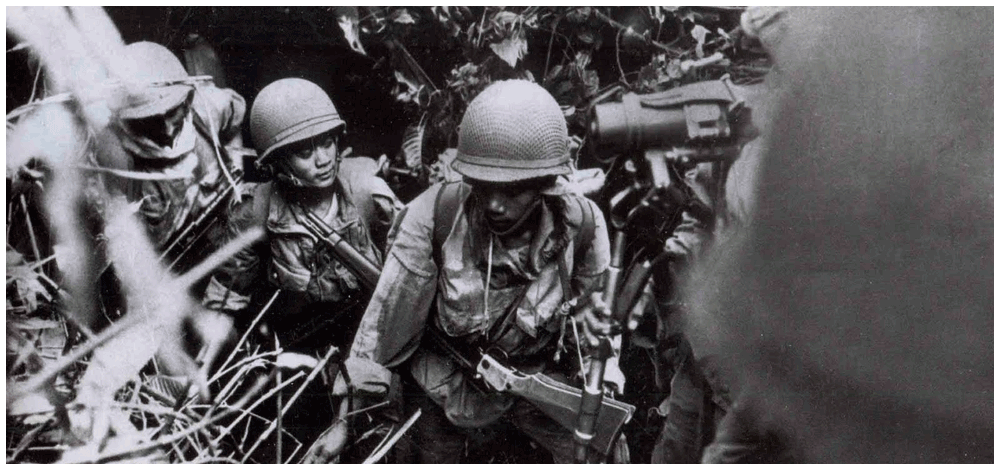
| Top |
 The Fusil MAS Mle 1936 LG48 (Lance Grenade)
The Fusil MAS Mle 1936 LG48 (Lance Grenade)
Rifle grenades were a core element of French tactics, but the Mle 1936 was not intended to be a front-line battle rifle. When it became apparent that it would serve on the front line for some time French military units called for better grenade launching tools than VB Mle 1915 that had been in use during World War Two. In particular infantry units wanted a more useful sighting system, and a design that did not require a special attachment to the rifle. French infantry officers wanted the number of potential grenadiers increased, so a light-weight and permenant fixture to the Mle 1936 was sought.
In 1948 Manufacture d'armes de Saint-Étienne started producing the Fusil Mle 1936 Lance-Grenades 48, a version of the MAS with sights for launching grenades. The indirect sights were simple in design, a soldier need only hold them horizontal to the ground, insert a rifle blank, and fire the grenade - range is set by a simple screw mechanism. The entire package was significantly lighter than the older VB grenade system, and it could be issued to soldiers who were not even tasked with grenade launching. During the Indochinese war the LG48 served as a key portion of each sections firepower, with the anti-tank grenades serving as bunker busters, and the high-explosive grenades tackling entrenched machine guns.
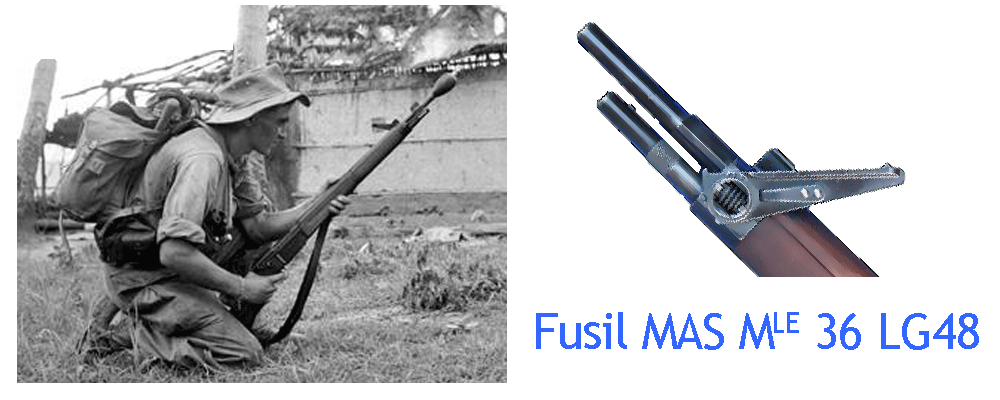
The Mle 36 LG48 was a temporary solution to get rifle grenades, an essential part of French infantry tactics, into infantry teams. The mechanism would be repeated on the MAS Mle 49 semi-automatic rifle and proved very successful. The French though were in the process of transitioning to a NATO standard 22mm blank fired rifle grenades. Starting in 1950 the French adopted a series of innovative grenades, requiring a weapon with a 22mm flash hider to launch them. The result was the MAS Mle 36/51. Most Mle 1936 LG48 were converted to the 1936/51 standard in the field as these kits and ammunition became available. Original LG48s are very rare, especially with matching number, and can command high prices. The condition of many LG48s in private hands are rough as many of these weapons were imported by soldiers who captured them in the Vietnam war.
| Top |

 The MAS Mle 1936/51 had a number of refinements that made it an excellent grenade launching platform. The basic design of the grenade launcher was the same as the Mle 1936 LG48. A sight was mounted onto the front nose guard of the rifle. The sight could be swung into position to help the infantryman measure a 45 degree angle accurately for indirect fire. The sight had a small notch and blade in it. The infantryman could then dial in the range they wanted using the side dial (A). The dial moved a screw that advanced or lowered a device on the barrel that limited how far down on the barrel a 22mm grenade would it. This device was graduated from 100 meters to 380 meters, the normal minimum and maximum range of indirect fire. This system was extremely accurate and the Mle 1936/51 was considered an extremely accurate grenade launching platform.
The MAS Mle 1936/51 had a number of refinements that made it an excellent grenade launching platform. The basic design of the grenade launcher was the same as the Mle 1936 LG48. A sight was mounted onto the front nose guard of the rifle. The sight could be swung into position to help the infantryman measure a 45 degree angle accurately for indirect fire. The sight had a small notch and blade in it. The infantryman could then dial in the range they wanted using the side dial (A). The dial moved a screw that advanced or lowered a device on the barrel that limited how far down on the barrel a 22mm grenade would it. This device was graduated from 100 meters to 380 meters, the normal minimum and maximum range of indirect fire. This system was extremely accurate and the Mle 1936/51 was considered an extremely accurate grenade launching platform.
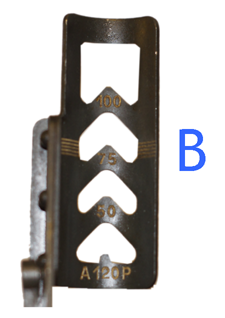 One change the MAS Mle 1936/51 was the inclusion of direct-fire sights. NATO and France in the late 1940s were developing a new generation of extremely effective rifle grenades including anti-tank grenades. During the frantic action of 1940 the French infantry had been faced with an onslaught of German armor. French armor, equal to or superior to the German equivalent, was lost in a combination of poor deployment, poor tactics, and air assault. The result was that French mechanized infantry often were forced to fight German combined arms formations with no real way to respond to tanks at close range. In desperation, many French infantry units adopted the tactic of firing grenades from grenade launchers at tanks. This tactic proved costly for the Germans, who lost dozens of tanks to French infantry, and nearly stalled their advance.
One change the MAS Mle 1936/51 was the inclusion of direct-fire sights. NATO and France in the late 1940s were developing a new generation of extremely effective rifle grenades including anti-tank grenades. During the frantic action of 1940 the French infantry had been faced with an onslaught of German armor. French armor, equal to or superior to the German equivalent, was lost in a combination of poor deployment, poor tactics, and air assault. The result was that French mechanized infantry often were forced to fight German combined arms formations with no real way to respond to tanks at close range. In desperation, many French infantry units adopted the tactic of firing grenades from grenade launchers at tanks. This tactic proved costly for the Germans, who lost dozens of tanks to French infantry, and nearly stalled their advance.
In facing the Russians, who after 1950 appeared to the French to be their primary enemy in the next twenty years, the French again were matched against a force that was armor heavy and prepared to fight a combined arms action. The French decided to develop and deploy a plan for layered defense against armor where Russian heavy vehicles were not ought by specialized units, but by every arm of the French army.
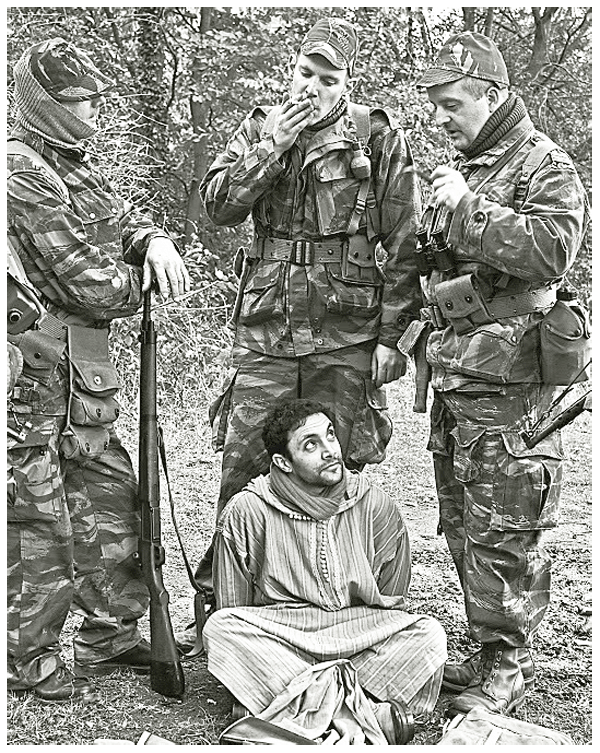 For the French the infantry would have access to a range of very cheap, effective anti-tank weapons, with the theory that if a four soldier infantry team could eliminate a fr75,000 tank with a fr300 missile or a fr.25 grenade, then the size and expense of the armor forces could be reduced, and those forces could concentrate on counterattacks rather than protecting vulnerable infantry formations. The result was a series of very powerful 22mm anti-tank rifle grenades that were widely issued to French infantry, and still remain in service. These grenades on paper looked weaker than the Warsaw pact RPG-2 series weapons that the French would encounter in the Indochinese War, but in practice having each section of infantry equipped with these weapons proved to be a key advantage because it did not remove a rifleman from the team.
For the French the infantry would have access to a range of very cheap, effective anti-tank weapons, with the theory that if a four soldier infantry team could eliminate a fr75,000 tank with a fr300 missile or a fr.25 grenade, then the size and expense of the armor forces could be reduced, and those forces could concentrate on counterattacks rather than protecting vulnerable infantry formations. The result was a series of very powerful 22mm anti-tank rifle grenades that were widely issued to French infantry, and still remain in service. These grenades on paper looked weaker than the Warsaw pact RPG-2 series weapons that the French would encounter in the Indochinese War, but in practice having each section of infantry equipped with these weapons proved to be a key advantage because it did not remove a rifleman from the team.
The MAS Mle 1936/51 has a direct-fire sight recessed on the top of the weapon attached to the indirect fire sights. The sights add a second position, a 25 degree sighting angle that allows 25, 50, 75, and 100 meter firing ranges for the heavier rifle grenades. To aid in accuracy for firing grenades from the shoulder a rubber butt stock cover was eventually developed (6). The weapon retained its bayonet and all parts were otherwise identical to the earlier Mle 1936 models. Due to the limitations of the M1 Garand (7) (then in common French service) as a grenade launching platform the MAS Mle 1936/51 was issued to designated grenadiers in units that carried this rifle. Many LG48s and standard Mle 1936 were converted in unit armories to Mle 1936/51 standards, and the rifle remained a popular weapon with soldiers even after semi-automatic rifles were widely issued.
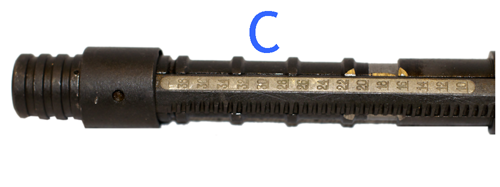
Currently the Mle 1936/51 is the most expensive of the standard issue MAS Mle 1936 but still remains a lower cost rifle compared to many other repeating rifles of the era. Since armories did many conversions on older weapons, and parts kits exist, nearly any stock MAS Mle 1936 can be converted to the 1936/51 standard.
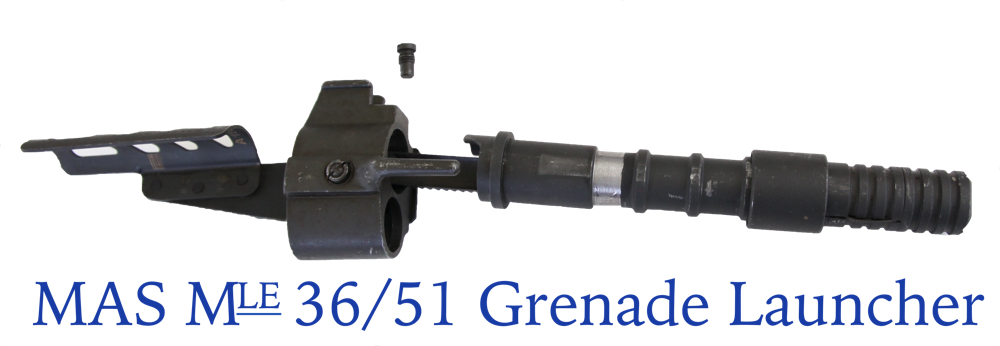
| Top |
| F 001 - 99,999 | July 1936 to August 1937 |
| G 001 - 99,999 | September 1937 to November 1939 |
| H 001 - 99,999 | December 1949 to June 1940 |
| J 001 - 99,999
K 001 - 99,999 L up to 4500 |
Both J and K rolled serial numbers have parts associated with middle 1940 manufacture and may have been assembled after the occupation by the Vichy or German governments. |
| No Serial Number | 1941-1944 German Occupation |
| L 4500 - 99,999 | October 1944 - December 1945 |
| M 001 - 99,999 | December 1945 - August 1946 |
| N 001 - 99,999 | September 1946 - October 1947 |
| P 001 - 99,999 | November 1947 - December 1948 |
| Q 001 - 99,999 | Janurary 1948 - Janurary 1951 |
| FG 001 - 99,999 | 1950 - 1952 |
| FH 001 - 99,999 | 1952 - 1955 |
| FJ 001 - 19,xxx | 1955 - 1957 |
| A great deal of confusion exists around how many MAS Mle 1936 were made, what year they were made or assembled, and how many of each model were finally produced. Assuming no broken serial number and NAZI era production in the tens of thousands, there could have been made as many as 1.3 million rifles made over its entire production history. The dates given above for production dates should not be considered any more than a rough guide as overlaps exist, weapons of questionable providence surface all the time (such as a FG serial weapon with a 1940 barrel mark I recently found, implying a newer receiver was mated to an older barrel at some point). | |
| Top |
During World War Two the Vichy French, the Free French, and the Germans used the Mle 1936. The Germans issued it to units in France stationed as garrison or protecting the coast, designating the weapon the Gewehr 242(f). During the Vichy period and the German occupation a small but unknown number of Mle 1936 rifles were produced by Manufacture d'armes de Saint-Étienne. These weapons were not given serial numbers and the number of weapons, parts sets, or spare parts produced during this period were lost when the MAS offices where ransacked during the liberation in 1944 as were a large number of weapons in the arsenal.
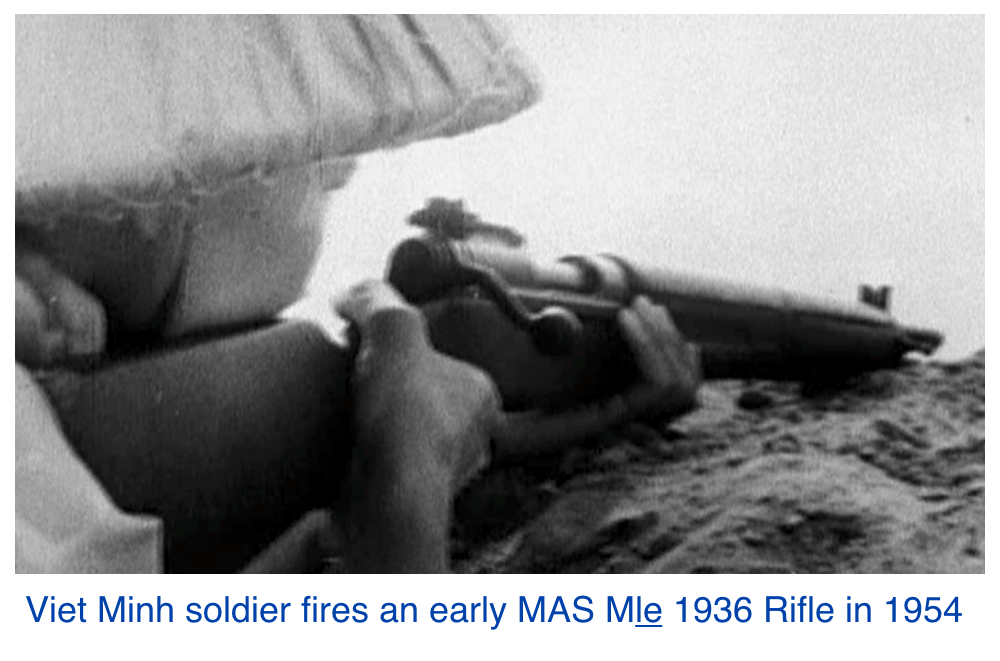
The MAS Mle 1936 was widely used in former French colonies, including Vietnam (9) and Algeria. Syria, Cameroon, Chad, and Niger all issued the 1936 in the early 1950s until they could be replaced with more modern weapons, while the weapon was common on African arms markets until the 1960s.
| Top |
The End of French Service
The Fusil MAS Mle 1936 was taken from production in late 1957 as and replaced by the Fusil MAS Mle 1949/56. They continued to serve in the French military, then were transferred into the hands of Gendarmerie units (often to be used as grenade launchers for riot control situations), finally passing from use in the late 1970s.
The 1936 remains in service with the French military in the form of the FR-F1, FR-F2, FR-G1, and FR-G2. These weapons were adopted in the early 1960s built on new (and very high quality) receivers. Elements of these designs included free-floating barrels, well-designed muzzle brakes, and in later designs, a bolt with a third locking lug. The earliest of these weapons were chambered for the 7.5x54mm, but most were converted to 7.62x51mm. The design was noted for its accuracy - it was so accurate that many NATO shooting contests would not allow it to compete.
| Owning the MAS 1936 |
The Fusil Mas Mle 1936 has entered the United States in numbers only rivaled by the Berthier weapons. The first weapons arrived in the 1940s, brought back by World War Two veterans after capturing them in German hands in Europe. The author has one such weapon with a 1940 serial number and barrel marking. Many of these weapons were converted to use as sporters - usually retaining a full-length barrel and original black paint finish, but replacing the 1936 stock set with a cheap commercial stock. All of these weapons retain their 7.5x54mm calibre. It is common when these weapons are found to convert them back to their original service grade as stocks are fairly common as of this writing, although the price has been rising rapidly in the past several years.
 A similar early variant was imported by California gun shop Golden State Arms, called the Santa Fe Model 1949. These rifles generally are shortened to 16 inch barrels, with cheap laminated stock sets. Golden State Arms sold these weapons in the original 7.5x54mm as what would today be called a scout rifle, and many were used in the west as truck guns or on ranches. The weapon was moderately popular and can commonly be found at gun shows, although the modifications made to the rifle limit its historical value except to collectors of Golden State Arms imports.
A similar early variant was imported by California gun shop Golden State Arms, called the Santa Fe Model 1949. These rifles generally are shortened to 16 inch barrels, with cheap laminated stock sets. Golden State Arms sold these weapons in the original 7.5x54mm as what would today be called a scout rifle, and many were used in the west as truck guns or on ranches. The weapon was moderately popular and can commonly be found at gun shows, although the modifications made to the rifle limit its historical value except to collectors of Golden State Arms imports.
Several hundred Mle 1936 were captured in the Vietnam war and brought back by United States soldiers. These weapons are generally in poor condition, and can sometimes be found with slogans carved into their stocks in Vietnamese. All known "bring back" Mle 1936 are chambered in 7.5x54mm, although the MAS action was modified for other calibres by Vietcong gunsmiths. Most collectors will not accept these weapons as legitimate unless they are accompanied by the appropriate paperwork.
The most common source of the Mle 1936 is importers such as Century Arms who purchased large stocks of the weapons when French arsenals started to sell them in the 1980s. 1936 models sold by Century Arms were available in several grades and can be nearly unfired since their arsenal refinish. All of these weapons are marked by Century Arms. Some of the weapons were converted to 7.62x51mm. The strength of the Mle 1936 action makes these conversions generally safe, but the gunsmiths at Century arms often removed metal components from the stocks when they shortened the Mle 1936 barrels. The results are that most Century conversions cannot use unmodified forstocks, and they will slowly chew through the modified stocks they are equipped with since they lack the metal attachments of the original weapon. A competent stock maker and gunsmith can fix this, but the expense can be greater than the purchase price of the weapon.
A common complaint of the MAS Mle 1936 is that the sights are not adjustable for windage. French armorers adjusted the sights by replacing the rear sight peep with one that was drilled offset to account for the weapon's strike point. Currently there is an excellent set of scope mounts available for the MAS Mle 1936 as well as a trigger replacement.

| Top |
| Notes |
(1) The MAS Mle 1932 is listed by some sources as an issue weapon, but like the MAS Mle. 1940 and the Berthier 1902 m37 there is no evidence that the weapon was issued as more than a test platform. MAS 1934 and 1935 variants do exist, but only limited numbers were made and they also were limited production run models that were essentially hand made for testing. Like the MAS Mle 38/39 it is probable that any weapons that were issued were returned after testing and destroyed for security reasons. (return)
(2) The author has only found weapons built prior to 1940 that retained their original hardware are captured weapons. Imported MAS Mle 1936 tended to come from two sources: Golden State, who cut down the barrels of the weapons and sold them as cheap scout type rifles with new wooden forearms and butts, and those imported by Century International Arms, which were purchased either refurbished by the arsenals in France (where they probably lost their original pre-1950 hardware) or mixed and matched from poor condition weapons by CAI itself (return).
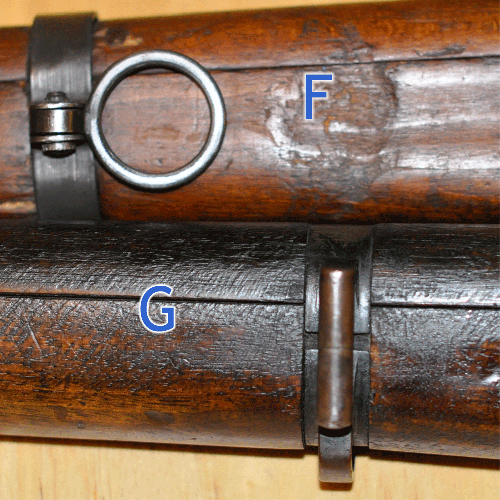 (3)Another view of the shoulder strap design, one from before WW2 on a weapon made early in 1939 (G) and one from a weapon made in 1952 and captured in Vietnam, then recaptured by U.S. forces and returned to the United States. (F) is a simple one-piece stamping while G is a three piece forged steel part. Note the color of the stocks. At first the author thought G had been modified by a previous owner, but the stock turned out to be walnut rather than the beech found in weapon (F).
(3)Another view of the shoulder strap design, one from before WW2 on a weapon made early in 1939 (G) and one from a weapon made in 1952 and captured in Vietnam, then recaptured by U.S. forces and returned to the United States. (F) is a simple one-piece stamping while G is a three piece forged steel part. Note the color of the stocks. At first the author thought G had been modified by a previous owner, but the stock turned out to be walnut rather than the beech found in weapon (F).
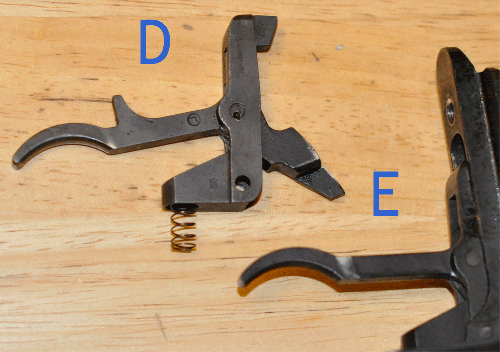 (4) The author has found two trigger types on the weapons. (D) represents a newer FG series weapon, and (E) an older G series weapon. It is not know what the functional difference in the design is except D may block excessive trigger travel. (return)
(4) The author has found two trigger types on the weapons. (D) represents a newer FG series weapon, and (E) an older G series weapon. It is not know what the functional difference in the design is except D may block excessive trigger travel. (return)
(5) The MAS Mle 1936 CR39 was imported into the United States in very small numbers and are now quite rare. (return)
(6) Rubber butt pads were made from 1951 on, but were far less common in standard use than the quantities on the market would lead one to believe. The primary use was to allow a firer to launch heavier grenade rifles in direct fire mode. Grenadiers otherwise fired their grenades with the butt pressed into the ground. (return)
(7) The M1 Garand's en-bloc clip made it difficult to quickly move from grenade launching to standard ammunition. (return)
(8) Until the FG - FJ series of weapons, the MAS Mle 1936 followed French practice if using a cursive letter at the head of a set of Arab numerals. These letter can be difficult to read (and indeed, they were difficult to read even for French armorers and soldiers, leading to excessive confusion). The MAS armory starts the numbering of its rifles at F, and in the case of the MAS Mle. 1936, recycled back to F with an additional letter for its later production runs.


(9) Popular misconceptions often assigns the guerrilla movements of the 1950s and 1960s the AK-47 as both their most common arm and also a symbol of their revolutions. In fact the AK-47 experienced years of slow production and teething problems, afterwards the bulk of its production was devoted to arming the main forces of the Warsaw Pact. Until the 1970s the main arm of criminal, terrorist, and guerrilla forces was a wide range of World War Two surplus weapons. In the Vietnam Conflict of the 1960s the Vietcong were armed with a wide range of rifles including the MAS Mle 1936. Tens of thousands of these weapons were captured after Dien Bein Phu and were in turn captured by United States and Allied forces. (return)
| Top |
| Citations |
Bayonets: An Illustrated History
An Illustrated Companion to the First World War
Pershing - The Soldiers' General
Small arms of the world: A basic manual of small arms
Small Arms Of The World: The Basic Manual Of Military Small Arms
Greenhill Military Small Arms Databook
Collecting Classic Bolt Action Military Rifles
Allied Rifle Contracts in America - Mosin-Nagant, Mauser, Enfield, Berthier, Remington, Savage, Winc
